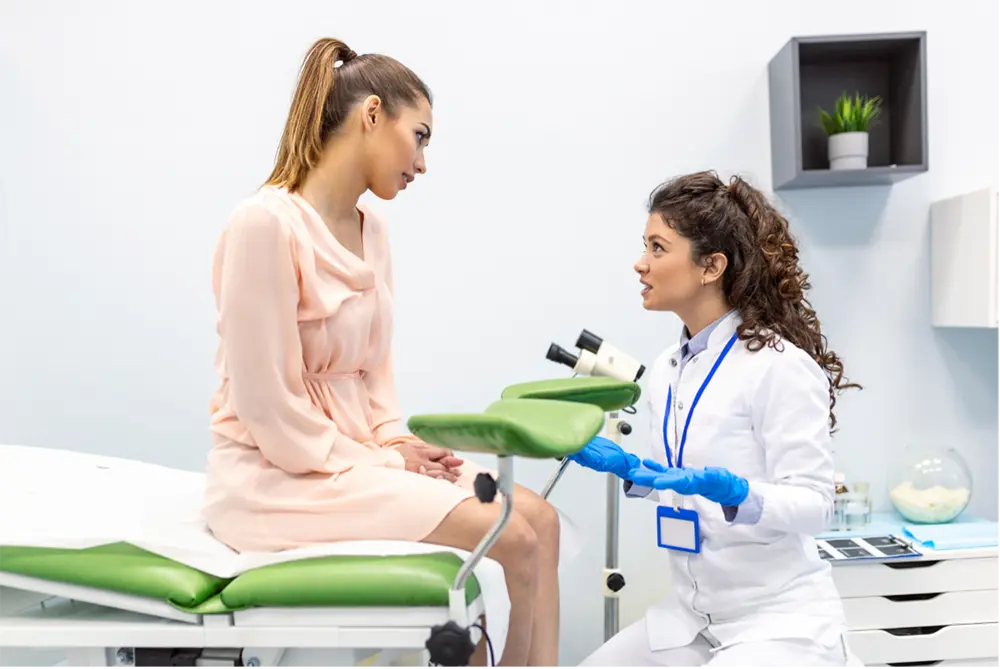by Tracie Swearingen, RD, CSO, LD
 Years ago, the most important reason for adequacy of vitamin D was to maintain bone health. Vitamin D promotes absorption of calcium and phosphorus, which are then deposited to make bones and teeth stronger. (1) Without vitamin D, bones can become thin, brittle or misshapen, as in rickets in children and osteomalacia in adults. Adequate calcium and vitamin D help to prevent osteoporosis in adults as well. (2)
Years ago, the most important reason for adequacy of vitamin D was to maintain bone health. Vitamin D promotes absorption of calcium and phosphorus, which are then deposited to make bones and teeth stronger. (1) Without vitamin D, bones can become thin, brittle or misshapen, as in rickets in children and osteomalacia in adults. Adequate calcium and vitamin D help to prevent osteoporosis in adults as well. (2)
The benefits of vitamin D are being continually researched. Now vitamin D is thought to possibly prevent and treat a variety of long term health problems. A lack of vitamin D has been linked to cancer, asthma, type I and type II diabetes, high blood pressure, Alzheimer’s and autoimmune diseases such as multiple sclerosis, and Crohn’s Disease. (3) More research is still needed on these areas. (4)
It is difficult to obtain adequate vitamin D from food alone, as few foods naturally contain vitamin D. (3) It is found in fortified milk, cheese, egg yolks, the flesh of fatty fish, cod liver oil, beef liver and fortified breakfast cereals. Our body can make its own vitamin D from ultraviolet B rays too. Vitamin D3 is made in your skin when exposed to the sun. According to the vitamin D council, vitamin D production takes “half the time it takes for your skin to turn pink and begin to burn”. It could take 15 minutes for a very fair skinned person or up to 2 hours for a dark skinned person. Your body can produce 10,000 to 25,000 IU of vitamin D in little under the time it takes your skin to turn pink. (3) We have depended on the sun for our vitamin D requirement for years. However with current recommendations to avoid sun exposure, this has put us at risk for vitamin D deficiency. (5) Sun protection of an SPF 15, absorbs 99% of the incident UVB radiation and therefore will decrease the synthesis of vitamin D3 in the skin by 99%. (6) UV radiation is a carcinogen (involved in causing cancer) and is responsible for most of the estimated 1.5 million skin cancers that occur annually in the United States. Therefore it is important to limit exposure of the skin to sunlight. (5) There are no studies that can tell us if UVB induced synthesis of vitamin D can occur without increased risk of skin cancer. (7) The Skin Cancer Foundation cautions against intentional exposure to sunlight or tanning beds to obtain vitamin D, due to the health risks of UV exposure. (8)
Those at risk for vitamin D deficiency include:
- Darker skinned individuals. Light skin makes vitamin D more quickly. (7)
- People that are indoors often or those who cover a lot of their skin. (9) (10) The more skin exposed, the more vitamin D is produced.
- Older individuals with thinner skin, as they can’t synthesize vitamin D as well. (7)
- Obese individuals and those who have had a gastric bypass. (7)
- Breastfed infants not given a vitamin D supplement of 400 IU/day. (11)
- People with inflammatory bowel disease and other conditions causing fat malabsorption. (12)
- Subjects living at higher latitudes are at an increased risk for developing vitamin D deficiency, due to decreased UVB radiation reaching the earth's surface, especially during the winter months. It has been noted that during the winter months in Boston (latitude of 42°N), vitamin D cannot be made in the skin between November and February. (13) Minnesota is at a latitude of 46°N, which also makes us at a higher risk of vitamin D deficiency/insufficiency. In the 1980s and 1990s, several observations suggested that living at higher latitudes increased the risk of developing and dying of colon, prostate, breast and several other cancers. It was suggested that an association between diminished vitamin D3 production and vitamin D deficiency may exist. (14)
There is controversy regarding how much vitamin D supplementation is adequate and how to obtain it. These are some different recommendations for daily intake from various organizations: (3)
| Vitamin D Council | Endocrine Society |
Food and Nutrition Board/ |
|
| Infants | 1,000 IU/day | 400-1,000 IU/day | 400 IU/day |
| Children |
1,000 IU/day per 25lbs body weight |
600-1,000 IU/day | 600 IU/day |
| Adults | 5,000 IU/day | 1,500-2,000 IU/day | 600 IU/day, 800 IU/day for seniors |
Part of the reason for the confusion on how much vitamin D you need is based on the results of different research studies. Also certain disease states can change the amount of vitamin D you need. You should have your vitamin D checked if you are at risk for vitamin D deficiency/insufficiency (as noted above), have a medical condition that increases risk for vitamin D deficiency/insufficiency, anyone with osteoporosis or a past history of a low-trauma fracture, low blood calcium or low blood phosphate. The test is a simple blood draw. The correct vitamin D lab to test is the 25(OH)D. (4)
| Vitamin D 25(OH)D range guidelines from various organizations: www.vitamindcouncil.org | ||||
| Vitamin D Council | Endocrine Society | Food and Nutrition Board | Testing Laboratories | |
| Deficient | 0-30 ng/ml | 0-20 ng/ml | 0-11 ng/ml | 0-31 ng/ml |
| Insufficient | 31-39 ng/ml | 21-29 ng/ml | 12-20 ng/ml | |
| Sufficient | 40-80 ng/ml | 30-100 ng/ml | >20 ng/ml | 32-100 ng/ml |
| Toxic | >150 ng/ml | |||
The Food and Nutrition Board recommendations are the “official” recommendations by the United States government. The Vitamin D Council is a 501(c)(3) nonprofit organization working to educate the public on vitamin D, sun exposure and health. Further evaluation needs to take place regarding what an adequate intake of vitamin D should be and what the most ideal 25(OH)D level is. The literature over the past decade suggests that the Institute of Medicine’s Food and Nutrition Board recommendations are inadequate. (14)
There are 2 forms of vitamin D - vitamin D2 and vitamin D3. Generally over the counter vitamin D supplements are in the vitamin D3 form. Prescription forms are generally Vitamin D2. It appears that at nutritional doses vitamins D2 and D3 are equivalent, but at high doses vitamin D2 is less potent. (2) Discuss with your doctor what form will be best for you.
Can you supplement with too much Vitamin D? Vitamin D is a fat-soluble vitamin, which means it dissolves in fat and is stored in tissues. Because it is stored, it can accumulate to toxic levels, which can cause health consequences. Due to the increased awareness of the possible risks of vitamin D deficiency/insufficiency, consumers may be taking higher doses than recommended in a “more has to be better” attitude. Consumers do not realize the risks of this. Vitamin D toxicity is usually caused by megadoses of vitamin D supplements – not by diet or sun exposure. It can lead to a buildup of calcium in the blood. This hypercalcemia can lead to a poor appetite, nausea, vomiting, weakness, frequent urination and kidney problems. If you are taking a higher dose vitamin D for a lab tested deficiency/insufficiency per your physician, it is important to have your blood level monitored. (15) This should be checked 3 months after beginning treatment. (4)
If you choose to take more vitamin D than is recommended, below are the safe maximum amounts according to the following groups: (3)
| Vitamin D Council | Endocrine Society | Food and Nutrition Board | |
| Infants | 2,000 IU/day | 2,000 IU/day | 1,000-1,500 IU/day |
| Children | 2,000 IU/day per 25 lbs body weight | 4,000 IU/day | 2,500-3,000 IU/day |
| Adults | 10,000 IU/day | 10,000 IU/day | 4,000 IU/day |
Bottom Line: The risk of vitamin D deficiency/insufficiency is high, especially here in Minnesota. There is a lot of conflicting information and recommendations regarding why Vitamin D may be beneficial beyond bone health. This includes how much vitamin D you should take to maintain a sufficient level of vitamin D and what is considered a sufficient vitamin D level in the body. There is more research needed to be done. Consult with your health care provider regarding getting your vitamin D level tested. It is important to always consult with your health care provider before taking any over the counter supplements.
References
- eatright.org Vitamin D deficiency in kids – accessed 4/6/15.
- National Institutes of Health – Vitamin D Fact Sheet for Health Professionals – accessed 4/6/15.
- vitamindcouncil.org – accessed 4/4/15
- uptodate.com – accessed 4/6/15
- Wolpowitz D, Gilchrest BA. The Vitamin D questions: how much do you need and how should you get it? J Am Acad Dermatol 2006;54:301-17.
- Matsuoka LY, Ide L, Wortsman J, MacLaughlin JA, Holick MG. Sunscreens suppress cutaneous vitamin D3 synthesis. J Clin Endocrinol Metab 1987;64;1165-8.
- Institute of Medicine, Food and Nutrition Board. Dietary Reference Intakes for Calcium and Vitamin D. Washington, DC: National Academy Press, 2010)
- skincancer.org – accessed 4/4/15
- Webb AR, Kline L, Holick MF. Influence of season and latitude on the cutaneous synthesis of vitamin D3: Exposure to winter sunlight in Boston and Edmonton will not promote vitamin D3 synthesis in human skin. J Clin Endocrinol Metab 1988;67:373-8.
- Webb AR, Pilbeam C, Hanafin N, Holick MF. An evaluation of the relative contributions of exposure to sunlight and of diet to the circulating concentrations of 25-hydroxyvitamin D in an elderly nursing home population in Boston. Am J Clin Nutr 1990;51:1075-81.
- Wagner CL, Greer FR; American Academy of Pediatrics Section on Breastfeeding; American Academy of Pediatrics Committee on Nutrition. Prevention of rickets and Vitamin D deficiency in infants, children, and adolescents. Pediatrics 2008;122:1142-1152.
- Pappa HM. Bern E, Kamin D, Grand RJ. Vitamin D status in gastrointestinal and liver disease. Curr Opin Gastroenterol 2008;24:176-83.
- Tangpricha V. Vitamin D deficiency in the southern United States. South Med J. 2007 Apr; 100(4): 384-385.
- Holick M, Chen T. Vitamin D deficiency; a worldwide problem with health consequences. Am J Clin Nutrition 2008; 87(suppl):1080S-6S.
- mayoclinic.org – accessed 4/28/15



